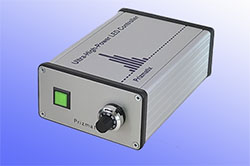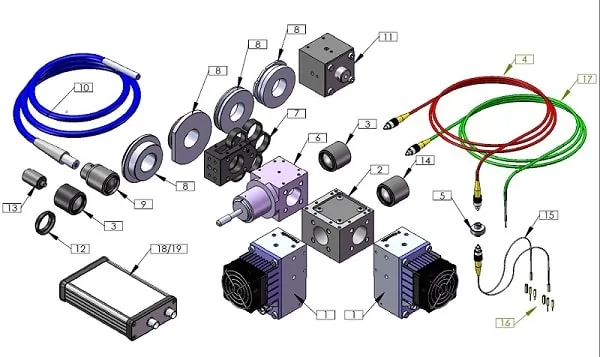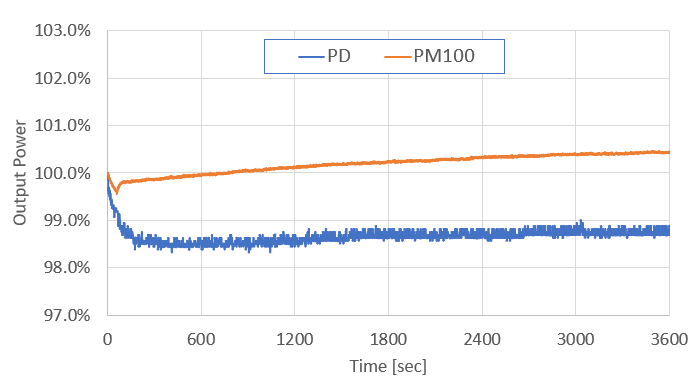The UHP-T-SR Collimated LEDs are Ultra-High Brightness LEDs series featuring unique LED chips. The UHP-T-SR proprietary thermal management enables us to drive the LED chips at high current density, making the UHP-T-SR series a top-brightness system. The UHP-T-SR collimated LED head features built-in adjustable aspheric collimator to provide collimated LED beam. The UHP-T-SR collimated LEDs can be connected to epi-fluorescence port of microscope by a microscope-adaptor, or the output light can be coupled to liquid light guide or even fiber
The unique design of UHP-T-SR features the high current driver installed inside the shielded metal enclosure of the LED head. This arrangement eliminates much of RFI / EMI interference common in high current light sources and makes UHP-T-SR especially useful in electrophysiology rig settings.
The UHPTLCC LED controller performs control functions. The controller features Optically Isolated TTL and Analog Inputs. All these features make this product especially suited for electrophysiology rig applications.
UHP-T-SR collimated LEDs are available in a wide range of a specific excitation wavelengths (please see full list below). Please check full list of available UHP-T LEDs .
All Prizmatix LEDs feature a modular design that enables easy connection of collimated LED heads to beam combiners, filter wheel, beam switcher and numerous other components. Please see below the full list of available components and accessories. For example, several UHP-T-SR collimated LEDs can be easily assembled to a multi-wavelength fluorescence excitation light-source. The multi wavelength system can mix all Prizmatix collimated LEDs Mic-LED and UHP-T-LED.
Please use Prizmatix LED Spectra Viewer to simulate such multi-wavelength system. The input graph of LED Spectra Viewer shows spectra of collimated LEDs, dichroic mirrors and filters. The output graph shows the resulting illumination spectrum overplayed on the spectra of the selected fluorescence dyes.
Please see full list of UHP-T Collimated LEDs.
Please see full list of optional accessories below.
Key Features:
- Single ultra-high brightness LED chip provide highly homogeneous illumination over whole field of view.
- Excellent thermal management of LED die enables extreme performance.
- Shielded LED head with high current driver, low RFI/EMI.
- Optically isolated TTL input for external triggering (no shutter needed) or strobe operation.
- Optically isolated Analog input (0-5V) for LED power control by external device like D/A interface
- Computer control via USB by Windows software, LabView VI or uManager (optional).
- Long life (no lamp or laser tube replacement required)
- Compatible with Prizmatix modular Microscope-LED Light Source products family - see below for details.
- Special low optical noise model available for detection of small signals (option).
Prizmatix LEDs modular versatility
Applications:
- Fluorescence microscopy in electrophysiology rig
- Confocal microscopy
- Multi-wavelength systems
- Bio analysis
- OEM
Benchtop LED Current Controller Specifications | |
|
Prizmatix offer several types of UHP-T-LED current controllers each optimized for specific requirements. UHPTLCC-02: Analog controller featuring precision power control by 10 turns potentiometer or by Analog input. TTL input is provided for fast On/Off strobing. UHPTLCC-02-USB : Manual or Computer power control via USB. TTL input is provided for fast On/Off strobing. Reference photodiode can be connected to monitor the actual output power.
UHPTLCC-02-STBL: Like UHPTLCC-02-USB but with power stabilization enabled for long illumination periods (typically hours). To choose the one that best fit your application please visit UHPTLCC controller page. |

Click to enlarge
|
Electrical Specifications:
| Connectors for TTL and Analog Input | Optically isolated BNC | |
| Digital modulation frequency | Hz | DC-50000 |
| Rise / Fall time | μs | <2/<2 |
| Analog input voltage range | V | 0-5 |
| Analog modulation frequency | Hz | DC-~100 |
| Current controller supply voltage | V | 12 |
| Power adaptor input | 85-264 VAC, 47-63Hz, 1.5A |
General Specifications:
| Operation temperature range | °C | 10-35 |
| Storage temperature range | °C | -10-55 |
| Operative relative humidity (Non condensing) | % | <90 |
| Dimensions | See drawing below | |
| Head weight | g | 350 |
| Controller dimensions (L x W x H) | mm | 197 x 174 x 80 |
| Controller Weight | g | 400 |
| Power adaptor dimensions (L x W x H) |
mm | 167 x 67 x 35 |
| Power adaptor weight | g | 590 |
| Power adaptor safety | ||
| LED Head fan noise | dBA | 38 |
Mechanical Drawings
Standard UHP-T LED head:

The front thread is fully compatible with Thorlabs SM1 (1.035″-40) components for 1 inch optics. To connect directly the LED head to the epi-fluorescence port of fluorescence microscope, please use Microscope Adaptors (shown as items #8 in Optional Accessories section below).
When microscopy application requires prolonged illumination periods in continuous mode the cooling fan may be activated and disturb the imaging. In such cases please consider detached fan option as described in the drawing below:

* Specifications subject to changes without notice
Optional Accessories
For full details on optional accessories please see:
https://www.prizmatix.com/optogenetics/Optogenetics-LED-Light-Sources-and-Fiber-Optics.htm
 |
All Prizmatix's LED light sources can be easily configured for use in a wide variety
of applications by simply adding further components. These use a standard 1.035″ 40TPI
thread (SM1 compatible) or Prizmatix's 4-pin connection system.
The following table summarizes the most popular accessories according to application,
further information on individual part can be found below the table. Custom solutions
are also often available at a low cost: please
contact us with your specific requirements.
| # | Accessories | Common Applications | |||
|---|---|---|---|---|---|
| Optogenetics | Microscopy, Imaging |
Fiber delivery, Spectroscopy | |||
| in-vitro | in-vivo | ||||
| 1 | Prizmatix Ultra High Power LED Light Source |
♦ | ♦ | ♦ | ♦ |
| 2 | Beam Combiner - Combines several LEDs into one beam using a dichroic mirror |
♦ | ♦ | ♦ | ♦ |
| 3 | FCA - Fiber Coupler Adaptor couples an optical fiber to LED: SMA or FC connectors | ♦ | ♦ | ||
| 4 | Fiber Patch Cord - Polymer / silica optical fiber (single or multiple branches), SMA or FC connectors | ♦ | ♦ | ||
| 5 | Rotary-Joint - Fiber optic Rotary Joint for in-vivo optogenetics | ♦ | |||
| 6 | Beam Switcher - Changes direction of beam output (e.g. microscope to fiber) | ♦ | ♦ | ♦ | |
| 7 | Filter wheel - Takes up to six 1″ filters | ♦ | ♦ | ||
| 8 | Microscope Adaptors - Adaptors for epi-fluorescence ports of Nikon / Olympus / Zeiss / Leica microscopes | ♦ | ♦ | ||
| 9 | LLG-A - Couples Liquid Light Guide to LED system | ♦ | ♦ | ||
| 10 | LLG-3 / LLG-5 - Liquid Light Guide: 3mm or 5mm core | ♦ | ♦ | ||
| 11 | LLG-C - Collimates Light Guide beam for fluorescent microscope | ♦ | ♦ | ||
| 12 | C-Mount Adaptor - Used to mount LED on camera port of microscope | ♦ | |||
| 13 | Fiber Collimator - Specially designed to collimate high NA optical fibers | ♦ | ♦ | ||
| 14 | Reference Photodiode - Monitors LED system power output | ♦ | ♦ | ♦ | ♦ |
| 15 | Optogenetics-Fiber - For in-vivo applications, single or bilateral dual fiber | ♦ | |||
| 16 | Implantable Cannulae - Used with fiber patch cord in optogenetics | ♦ | |||
| 17 | Optogenetics-Fiber - For in-vitro applications: bare fiber protruding from thin stainless steel tubing | ♦ | |||
| 18 | Pulser - Programmable TTL pulse train generator | ♦ | ♦ | ||
| 19 | USB-TTL Interface - To control Prizmatix LEDs from Imaging software (e.g. microManager) via USB connection | ♦ | ♦ | ||
Any type of Prizmatix Ultra High Power LEDs can be combined to form multi-wavelength system. For more information on specific types please see following links: Mic-LEDs, UHP-LEDs. Beam Combiner [2]Beam Combiner module joins two discrete Prizmatix LEDs into one output beam using a built-in dichroic mirror at specified cut-off wavelength . FCA - Fiber Coupler Adaptor [3]All Prizmatix LED heads can be easily changed from collimated LED source to fiber coupled LED
configuration by means of Fiber Coupler Adaptor (SMA, FC or ST connector). . Fiber patch cords [4]Various fiber optic patch cords are available. Most popular patch cords are 1000 / 1500 / 2000 Rotary-Joint [5]Prizmatix Rotary Joint is especially designed for Optogenetics experiments with High NA fibers
equipped with FC connectors. Due to very low friction and smooth swivel the rotary joint is
suitable for use even with small mice.
See more info... Beam Switcher [6]The Beam Switcher accessory allows for Prizmatix LEDs installed
on a microscope to be used either as microscope epi-fluorescence illumination
or illuminating a specimen via a fiberoptic probe this feature especially useful
for in-situ Optogenetics studies.
See more info... Filter Wheel [7]The manual 6 positions filter wheel can be especially useful
for White LED sources. The Filter Wheel can be installed at the beam output
of LED or a Beam Combiner.
See more info... Microscope Adaptors [8]Adaptors enabling connection of Prizmatix LED light sources
to epi-fluorescence light port.
Adaptors for Nikon, Zeiss, Olympus and Leica microscopes are available.
See more info... LLG-A Liquid Light Guide Adaptor [9]The LED system can be quickly and easily attached to Liquid Light Guide by means of LLG-A Adaptor. For more details please see video clip LLG-3 / LLG-5 [10]The Liquid Light Guide is a common way to connect light source
to microscope epi-fluorescence port. Prizmatix can provide 3mm or 5mm core LLGs. LLG-C collimator XYZ [11]The Prizmatix LLG collimator is an XYZ adjustable collimator for 3mm core
Liquid Light Guide (LLG-3) with adaptor for the epi-illumination port
of fluorescence microscopes. This collimator can be equipped with Nikon, Olympus,
Zeiss or Leica adaptors.
See more info... C-Mount Adaptor [12]A standard C-mount thread adaptor (1-32 UN 2A thread), usually used to connect to trinocular microscopes. Collimator [13]The output from optical fiber is divergent relative
to fiber NA. In order to reduce the divergence angle a collimator module
can be used. Prizmatix's collimator is especially designed to fit thick core
high NA polymer optical fibers.
See more info... Reference Photodiode [14]Prizmatix reference photodiode is useful in order to monitor LED source power over time in experiments required exceptional stability over long time period. See more.. Optogenetics-Fiber for in-vivo [15]Prizmatix provides a full solution to the optogenetics in-vivo and in-vitro fiber optics. Made of silica or polymer high NA fibers, the high NA fibers are assembled to fit any research set-up with various combinations of connectors, ferrules, core diameters and lengths. This is example of a Y-shaped fiber for simultaneous in-vivo stimulation of two hemispheres. See more info... Implantable Cannulae [16]Prizmatix Implantable Fiberoptic Cannulae / Ferrules allow direct light stimulation
of certain deep brain regions in living animals. Each Cannula consists of a Zirconia ferrule
accommodating a high NA Silica optical fiber, protruding from the Zirconia ferrule at a desired length.
See more info... Optogenetics-Fiber for in-vitro [17]Prizmatix provides a full solution to the optogenetics in-vivo and in-vitro fiber optics.
Made of silica or polymer fibers, the high NA fibers are assembled to fit any research
set-up with various combinations of connectors, ferrules, core diameters and lengths.
This is example of a fiber with stainless steel tip with protruding bare fiber for
in-vitro activation of brain slices under a microscope.
See more info... Pulser [18]The Pulser USB to TTL interface box with user friendly software is
an easy way to generate trains of pulses for Optogenetics activation directly from your computer.
See more info... USB-TTL Interface [19]The microprocessor based device enabling simple control of Prizmatix LED sources from Windows based computer via USB. Application Examples:Optogenetics LED Light Source:Optogenetics illumination sources include lasers and LEDs,
and photoactivation can be done under a microscope or via
a fiber for in-vitro or in-vivo applications. Using a Prizmatix LED
illumination system for optogenetics studies provides many
advantages compared to laser-based systems.
|



